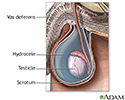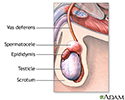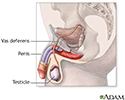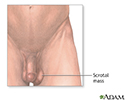Scrotal masses
Testicular mass; Scrotal growth
A scrotal mass is a lump or bulge that can be felt in the scrotum. The scrotum is the sac that contains the testicles.
Causes
A scrotal mass can be noncancerous (benign) or cancerous (malignant).
Benign scrotal masses include:
- Hematocele -- blood collection in the scrotum
- Hydrocele -- fluid collection in the scrotum
- Spermatocele -- a cyst-like growth in the scrotum that contains fluid and sperm cells
- Varicocele -- a varicose vein along the spermatic cord
- Epididymal cyst -- a swelling in the duct behind the testes that transports sperm
- Scrotal abscess -- a collection of pus within the wall of the scrotum
Scrotal masses can be caused by:
- Abnormal bulge in the groin (inguinal hernia)
- Diseases such as epididymitis or orchitis
- Injury to the scrotum
- Testicular torsion
- Testicular cancer
- Infections
Symptoms
Symptoms include:
- Enlarged scrotum
- Painless or painful testicle lump
Exams and Tests
During a physical exam, the health care provider may feel a growth in the scrotum. This growth may:
- Feel tender
- Be smooth, twisted, or irregular
- Feel liquid, firm, or solid
- Be only on one side of the body
The inguinal lymph nodes in the groin on the same side as the growth may be enlarged or tender.
The following tests may be done:
- Biopsy
- Urine culture
- Ultrasound of the scrotum
Treatment
A provider should evaluate all scrotal masses. However, many types of masses are harmless and do not need to be treated unless you are having symptoms.
In some cases, the condition may improve with self-care, antibiotics, or pain relievers. You need to get medical attention right away for a growth in the scrotum that is painful.
If the scrotal mass is part of the testicle, it has a higher risk of being cancerous. Surgery may be needed to remove the testicle if this is the case.
A jock strap or scrotal support may help relieve the pain or discomfort from the scrotal mass. A hematocele, hydrocele, spermatocele, or scrotal abscess may sometimes need surgery to remove the collection of blood, fluid, pus or dead cells.
Outlook (Prognosis)
Most conditions that cause scrotal masses can be easily treated. Even testicular cancer has a high cure rate if found and treated early.
Have your provider examine any scrotal growth as soon as possible.
Possible Complications
Complications depend on the cause of the scrotal mass.
When to Contact a Medical Professional
Contact your provider if you find a lump or bulge in your scrotum. Any new growth in the testicle or scrotum needs to be checked by your provider to determine if it may be testicular cancer.
Prevention
You can prevent scrotal masses caused by sexually transmitted diseases by practicing safe sex.
To prevent scrotal masses caused by injury, wear an athletic cup during exercise.
References
Germann CA, Holmes JA. Selected urologic disorders. In: Walls RM, Hockberger RS, Gausche-Hill M, eds. Rosen's Emergency Medicine: Concepts and Clinical Practice. 9th ed. Philadelphia, PA: Elsevier; 2018:chap 89.
Sommers D, Winter T. The scrotum. In: Rumack CM, Levine D, eds. Diagnostic Ultrasound. 5th ed. Philadelphia, PA: Elsevier; 2018:chap 22.
Hydrocele - illustration
Hydrocele
illustration
Spermatocele - illustration
Spermatocele
illustration
Male reproductive system - illustration
Male reproductive system
illustration
Scrotal mass - illustration
Scrotal mass
illustration
Review Date: 7/26/2021
Reviewed By: Kelly L. Stratton, MD, FACS, Associate Professor, Department of Urology, University of Oklahoma Health Sciences Center, Oklahoma City, OK. Also reviewed by David Zieve, MD, MHA, Medical Director, Brenda Conaway, Editorial Director, and the A.D.A.M. Editorial team.









